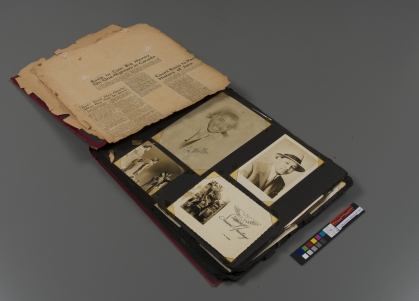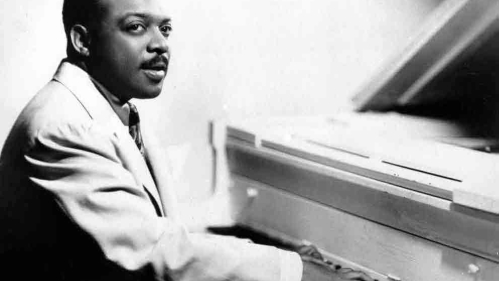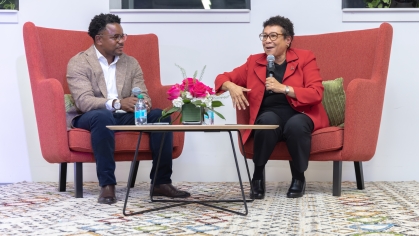The note is written on Frank Sinatra’s personal stationery and inscribed with the words, “Count – Swing, you mother! Ol’ Blue Eyes.’’
It’s one of nearly 1,000 artifact belonging to jazz giant William J. “Count” Basie and housed at the Dana Library at Rutgers–Newark, home to the Institute of Jazz Studies, the world’s largest and most comprehensive archive of jazz and jazz-related materials. This month, all papers from the Basie collection became available online for researchers and the public. More material, including digitized images of family scrapbooks, will be added next year. The archives can be found through the Rutgers University Library system at libraries.rutgers.edu/basie.
A small display of artifacts from the collection, including a pair of Basie’s brown Italian leather shoes, a gold piano-key necktie clip, and an engraved silver cigarette case are also on view at the institute, which is open to the public by appointment.

A native of Red Bank, Basie was a towering figure in the world of jazz, renowned as a pianist, composer, and big band leader, and recognized as the first Black artist to win a Grammy award in 1958. The collection provides insight into his artistry, career, personal life, and the era that shaped him.
“Count Basie is one of the most important figures in both jazz and American music of the 20th -century,’’ said Wayne Winborne, executive director of the institute. “His impact and influence as a bandleader and purveyor of hip swing cannot be overstated.’’
The collection, called the Count Basie Family Papers and Artifacts, is an essential resource for researchers in jazz, music, post-war American history, and American culture, especially Black American culture. It is also critical for scholars, educators, writers, filmmakers, students, and the general public because of its breadth and depth.
“Preserving his papers and artifacts is important because they allow for detailed examination of music and life in this country through rapid and often tumultuous musical, sociological, economic, and cultural changes,’’ said Winborne. “Plus, it’s just cool to see this stuff.’’
Since February, Elizabeth Surles, archivist at the Institute, along with Roxane Orgill, an archivist contracted for the project, have been sorting through boxes filled with scrapbooks, newspaper clippings, fan mail, family photos, home movies, telegrams, set lists, cuff links, engraved lighters, captain’s hats (a signature look for Basie), and other items to ensure they are properly archived and preserved.
To outsiders, it might look like random belongings, but after spending so much time with the Basie family’s things, Surles and Orgill can provide context, along with anecdotes about their discoveries.
Surles explains the significance of a set list and script from a WNEW radio broadcast dated August 11, 1946, when Count Basie and his Orchestra performed songs that included “Hob Nail Boogie” and “How Deep Is the Ocean.’’
“Radio was really important in the history of big bands,’’ said Surles.
Back then, broadcast signals were so powerful they could be picked up nationally — crucial for a band like Basie’s, which got its start in Kansas City, a town known for producing “hot” swing with a harder sound than other types of jazz. Also, during an American Federation of Music members strike in the early 1940s, many musicians could only make recordings from live shows or radio broadcasts because the union prohibited studio recordings.
Basie was born and raised in Red Bank, where a job changing reels at the local movie theater resulted in a piano-playing gig for silent films when the house musician failed to show up one day, according to Orgill, a former music critic and author of Dream Lucky: When Franklin Was in the White House, Count Basie Was on the Radio, and Everyone Wore a Hat. The book explores Basie’s early life and career in from his birth through the late 1930s.
Hoping to break into the New York and national music scene, Basie landed gigs in midtown and Harlem, where he met the legendary stride pianist Fats Waller, who taught Basie how to play the organ, his favorite instrument when jamming for fun at home. Shortly after, he was travelling the Midwest as a small jazz group pianist when a tour cancellation left him stranded in Kansas City. He wound up joining one of the city’s best bands–led by Bennie Moten – and soon founded his own group.
By then, he earned the nickname “Count,” and the Count Basie Orchestra would eventually make it to New York’s jazz mecca, 52nd Street, establishing an international name for itself.
While on the vaudeville circuit, Basie met his wife, Catherine, a burlesque dancer with a Tahitian-themed act whose stage name was Princess Aloha. They married and stayed together over 40 years until her death in 1983. Her life and keepsakes form a substantial part of the Basie collection and exhibition.
A civic-minded resident of the Basies’ neighborhood in Queens, Catherine was an avid fundraiser and community organizer and was deeply involved in the civil rights movement.
The collection includes a telegram to Catherine from Martin Luther King Jr., congratulating her on being honored by the New York Urban League. King calls her “one of the outstanding women of our time, adding “your sincere humanitarian instincts have created a great circle of admirers across our nation.’’
Winborne and others who worked on the collection are glad it shines light on Catherine Basie, too.
“She had a big, big life that people don’t know about,’’ said Orgill.
In addition to her community work, Catherine did the lion’s share of raising the Basies’ only child, Diane Elizabeth, who was born with severe cerebral palsy and given a short life expectancy. Loved dearly by her parents and raised at home against the conventional practice of the time, Diane would live to be 78, passing away this fall following a heart attack. She appears in in many family photos and home movies, playing with friends and relatives in the backyard pool.
“The collection gives you a real intimate look at Basies’ family life,’’ said Surles.
The Count Basie Collection Archival Processing Project was funded in part by the New Jersey Historical Commission, a division of the New Jersey Department of State, in addition to funding for conservation and preservation of the collection from the Institute of Museum and Library Services, National Park Service, National Endowment for the Arts, and National Endowment for the Humanities. For more information about the Institute of Jazz Studies, please visit libraries.rutgers.edu/ijs.



